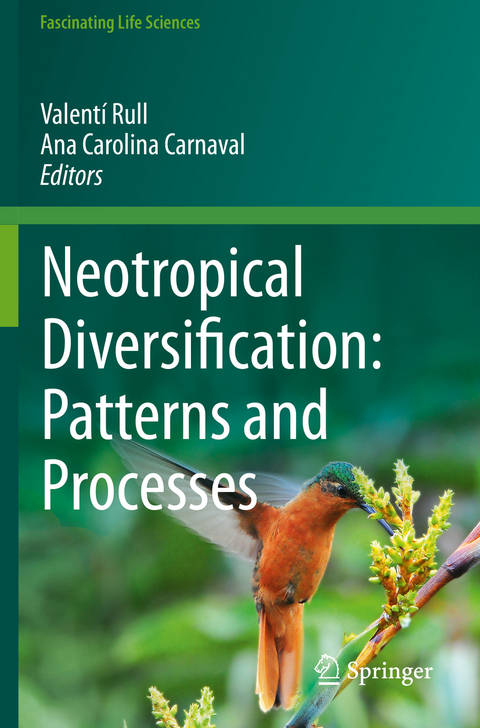
Neotropical Diversification: Patterns and Processes
Springer International Publishing (Verlag)
978-3-030-31169-8 (ISBN)
lt;b>Valentí Rull is a biologist with a Ph.D. in Paleoecology. Over the past 35 years, he has used past ecological evidence - mainly from palynology - to address topics such as i) the type and characteristics of biotic responses to environmental changes; ii) the role of human and climatic drivers as causes of ecological change; iii) the effects of tectonics, paleogeography and climate change on the origin of biodiversity; iv) hypotheses testing for long-term ecological processes; v) predictions on biotic responses to potential future climatic scenarios; and v) the development of better-informed strategies for biodiversity conservation. He has conducted his research in several temperate, tropical and subtropical regions, e.g. the northern tropical Andes, the Orinoco lowlands and delta, the Guayana region, the Maracaibo basin, Easter Island, the Azores and the Pyrenees.
Ana Carnaval was born and raised in Rio de Janeiro, Brazil, where she obtained her undergraduate degree in Biology from the Universidade Federal do Rio de Janeiro and her Master's degree in Zoology from the Museu Nacional. She holds a Ph.D. in Evolutionary Biology from the University of Chicago, and completed her postdoctoral training at the Museum of Vertebrate Zoology, University of California Berkeley. Currently an Associate Professor of Molecular Ecology at the City College of New York, her research group studies spatial patterns of biodiversity and underlying evolutionary and ecological processes, with the explicit aim of improving biodiversity prediction and conservation in tropical regions. Her projects focus on tropical biogeography, integrative uses of comparative phylogeography, GIS-based distribution models, current environmental data and paleoclimatic simulations, and animal physiology, particularly in the Brazilian Atlantic rainforest, and, to a lesser extent, the Amazonian forest and the Cerrado.
Chapter 1. Introduction.- Part 1. Neotropical diversity and diversification.- Chapter 2. Neotropical diversification: historical overview and conceptual insights.- Chapter 3. Beyond refugia: New insights on Quaternary climate variation and the evolution of biotic diversity in tropical South America.- Chapter 4. Tropical and subtropical in South America: a study of community turnover across environmental gradients.- Chapter 5. Evolutionary macroecology and the geographical patterns of Neotropical diversification.- Chapter 6. Evolutionary imprints on species distribution patterns across the Neotropics.- Chapter 7. Avian diversity in humid tropical and subtropical south American forests, with a discussion about their related climatic and geological underpinnings.- Chapter 8. Contrasting patterns of temporal diversification in Neotropical butterflies: An overview.- Chapter 9. Diatom diversity and biogeography across tropical South America.- Part 2. Regional biodiversity patterns and diversification processes.- Chapter 10. The origin and evolution of Amazonian species diversity.- Chapter 11. Patterns and processes of diversification in Amazonian white sand ecosystems: insights from birds and plants.- Chapter 12. Human contribution to Amazonian plant diversity: legacy of pre-Columbian land use in modern plant communities.- Chapter 13. On the young savannas in the land of ancient forests.- Chapter 14. The diversification of extant Angiosperms in the South America dry diagonal.- Chapter 15. Diversity, endemism, and evolutionary history of montane biotas outside the Andean region.- Chapter 16. Patterns of species and lineage diversity in the Atlantic rainforest of Brazil.- Chapter 17. Diversification in ancient and nutrient-poor Neotropical ecosystems: how geological and climatic buffering have shaped plant diversity in some of the world's neglected hotspots .- Chapter 18. Bioregions of Eastern Brazil, based on vascular plant occurrence data.- Chapter 19. Forests diversity in the Mexican neotropics: A paleocological view.- Chapter 20. Historical biogeography of Caribbean plants revises regional paleogeography.- Part 3. Taxon-based local and regional studies.- Chapter 21. Amphibians and reptiles of Venezuelan Guayana: diversity, biogeography and conservation.- Chapter 22. Origin of elevational replacements in a clade of nearly flightless birds - most diversity in tropical mountains accumulates via secondary contact following allopatric speciation.- Chapter 23. Clade-specific biogeographic history and climatic niche shifts of the southern Andean-southern Brazilian disjunction in plants.- Chapter 24. Biotic and landscape evolution in an Amazonian contact zone: insights from the herpetofauna of the Tapajós River basin.- Chapter 25. Diversification processes in lizards and snakes from the middle São Francisco River dune region.- Chapter 26. Unexpected beta-diversity radiations in highland clades of Andean Terraranae frogs.- Chapter 27. Disparate patterns of diversification within Liolaemini lizards.- Chapter 28. Diversification history of Neotropical Lecythidaceae, an ecologically dominant tree family of Amazon rain forest.- Part 4. IV. Epilogue.- Chapter 29. Conservation in the Neotropics - a final reflection.
| Erscheinungsdatum | 14.04.2021 |
|---|---|
| Reihe/Serie | Fascinating Life Sciences |
| Zusatzinfo | X, 820 p. 150 illus., 126 illus. in color. |
| Verlagsort | Cham |
| Sprache | englisch |
| Maße | 155 x 235 mm |
| Gewicht | 1388 g |
| Themenwelt | Naturwissenschaften ► Biologie ► Evolution |
| Naturwissenschaften ► Biologie ► Ökologie / Naturschutz | |
| Naturwissenschaften ► Biologie ► Zoologie | |
| Schlagworte | biodiversity • biogeography • climate change • Evolutionary Radiation • Neotropics • Paleoecology • phylogeography • Speciation • Species distribution • systematic botany |
| ISBN-10 | 3-030-31169-4 / 3030311694 |
| ISBN-13 | 978-3-030-31169-8 / 9783030311698 |
| Zustand | Neuware |
| Haben Sie eine Frage zum Produkt? |
aus dem Bereich


